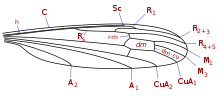Cylindrotominae
| Cylindrotominae | |
|---|---|
 | |
| Diogma wing vein | |
| Scientific classification | |
| Kingdom: | Animalia |
| Phylum: | Arthropoda |
| Class: | Insecta |
| Order: | Diptera |
| Suborder: | Nematocera |
| Infraorder: | Tipulomorpha |
| Superfamily: | Tipuloidea |
| Family: | Tipulidae |
| Subfamily: | Cylindrotominae |
| Genera | |
|
see text | |
The Cylindrotominae or long-bodied craneflies are a subfamily of crane flies. About 115 species occur worldwide. Some recent classifications elevated the group to family level, but this was not supported by more recent phylogenetic analyses,[1] thus they remain a subfamily.
Description
They are mostly large flies of around 11–16 mm and yellowish to pale brownish in colour. They have long, slender antennae with 16 segments; the wings, legs and the abdomen are all very long.
Biology
The larvae are all phytophagous (with the exception of the genus Cylindrotoma) and are found living on terrestrial, semiaquatic and aquatic mosses. The larvae of the genus Cylindrotoma live on various flowering plants. Adults are found in damp, wooded habitats.
Genera
- Cylindrotoma Macquart, 1834
- Diogma Edwards, 1938
- Liogma Osten Sacken, 1869
- Phalacrocera Schiner, 1863
- Stibadocera Enderlein, 1912
- Stibadocerella Brunetti, 1918
- Stibadocerina Alexander, 1929
- Stibadocerodes Alexander, 1928
- Triogma Schiner, 1863
References
- ↑ Petersen, M.J.; Bertone, M.A.; Wiegmann, B.M.; Courtney, G.W. 2010: Phylogenetic synthesis of morphological and molecular data reveals new insights into the higher-level classification of Tipuloidea (Diptera). Systematic entomology, 35: 526-545. doi: 10.1111/j.1365-3113.2010.00524.x
| ||||||||||||||||||||||||||||||||||||||||||||||||||||||||||||||||||||||||||||||||||||||||||||||||||||||||||||||||||||||||||||||||||||||||||||||||||||||||||||||||||||||||||||||||||||||||||||||||||||||||||||||||||||
This article is issued from Wikipedia - version of the Wednesday, October 08, 2014. The text is available under the Creative Commons Attribution/Share Alike but additional terms may apply for the media files.